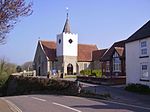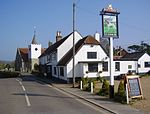Knighton, Isle of Wight

Knighton is a hamlet near to Newchurch on the Isle of Wight. The name should be pronounced as Kay-nighton to avoid confusion with the larger, homophonic village of Niton, near Ventnor. Knighton is situated under Knighton Down and has historically always been a part of the parish of nearby Newchurch. Knighton consists of little more than a collection of farm houses, most now turned to residential use. The only amenity in the settlement is a post-box. To the south is Knighton Sandpit Ltd which is an aggregate extraction company. The pit is also used for off-road driving events. This is however, a little way from the main residential area. Knighton Gorges Manor in Knighton was one of the grandest manor houses on the Isle of Wight. But when the owner's daughter married against his will, he had it demolished, rather than allowing her to inherit it. Hugh De Morville, one of the knights responsible for the murder of Thomas Becket, fled to Knighton Gorges. There was a medieval settlement in Knighton, but nearly all of the population moved to the nearby village of Newchurch to escape the “Black Death”. Flint arrow heads can still be found in fields surrounding the area. It was estimated that at one time, the hamlet contained up to 60 houses. Jimmy Tarbuck lived at Griggs Farm in the 1980s whilst performing in the nearby town of Sandown. Knighton is the home of the “Wight Crystal” drinking water company, whose water comes from Knighton. John Wavell and Anna Cowlam farmed Knighton farm after their marriage in 1735 in Newchurch. They were the great-great-grandparents of Archibald Wavell, 1st Earl Wavell (1883-1950), former Field Marshall and Viceroy of India.
Excerpt from the Wikipedia article Knighton, Isle of Wight (License: CC BY-SA 3.0, Authors, Images).Knighton, Isle of Wight
Geographical coordinates (GPS) Address Nearby Places Show on map
Geographical coordinates (GPS)
| Latitude | Longitude |
|---|---|
| N 50.678 ° | E -1.1998 ° |
Address
PO36 0NT
England, United Kingdom
Open on Google Maps








